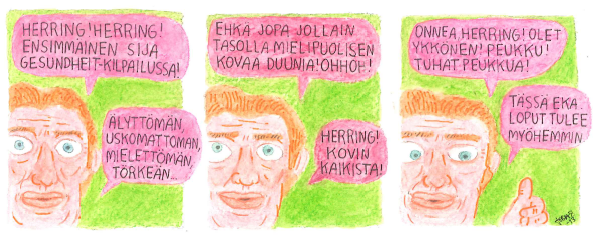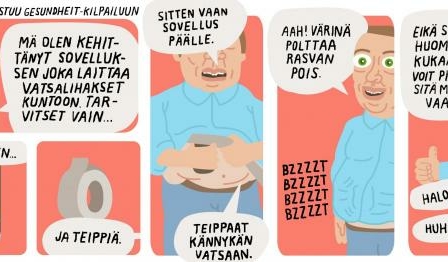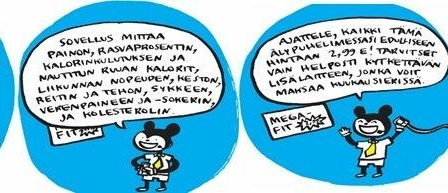Sitra’s Gesundheit prize for the gamification of healthcare was awarded to the developer of the hearing test game Herring, Johannes Koponen. Here are some of his observations from the Health 2.0 Fall Conference held in Santa Clara, California, USA.
The doctor always knows best. It is important to make a distinction between healthy and sick people, and to refer only to sick people as patients. Being ill is a private matter: patient histories should only be seen by nurses, not by the patient or at other hospitals. While funding healthcare services for the non-working population is just an unavoidable cost, doing the same for the rest of the population represents a productive investment.
How about busting these health myths?
FALSE: The doctor always knows best.
Doctors are medical specialists. However, emerging socio-technical systems sometimes provide access to information that even the most enlightened specialists cannot obtain.
Various systems based on comparing, sharing and interacting are producing truly novel information and activities. Imagine this: LinkedIn for patients.
As a concept, LinkedIn for patients has already existed for a long time – for example, PatientsLikeMe is an online service through which patients can share experiences with those affected by the same illness.
Having access to such information turns patients into experts in their own medical conditions, especially in the case of long-term illnesses. This is a remarkable asset worth exploiting rather than belittling. Through peer-to-peer data exchange, information on what treatments work for which patients can be disseminated faster than ever. What is more, patients’ understanding of their own medical conditions increases when they receive feedback from others in the same position. It should be emphasised here that information of this kind is intended to support a physician’s weighted, scientific diagnosis based on professional experience – not to override it!
There are also other options. The Quantified Self movement aims to improve self-knowledge through the use of new kinds of sensors, which are smaller and easier to manage. Linking more and more sensors to the internet will create an “internet of things”, with vast possibilities for sharing, analysing and contextualising personal health data.
But not all innovations need to be so technical in nature. Imagine this: informal care AirBnB.
The AirBnB service enables you to rent a vacant apartment in the same way you would a hotel room: perhaps a similar, reputation-based temp agency service could be developed for caregivers, if one does not already exist.
More efficient use of untapped resources would be one way of improving quality of life. A major share of healthcare is outsourced, meaning that it does not register in statistics – think of caregivers, for example. This does not mean that activities of this kind are not a burden on the national economy or individuals. Peer-to-peer support can help reduce these burdens.
Patients are not the only ones helped by the internet and “internet of things”. The first myth’s notion that decision-making is best left to one doctor also needs to be busted. When engaged in the proper manner, a group of specialists can have tremendous power. Imagine these: Github for drug combinations. Stack Overflow for nurses.
Github is an online developers’ service for building open source code applications together, while benefiting from each others’ insights. Game-like Stack Overflow is a question and answer site for professional and enthusiast programmers. It has what is probably the best-functioning concept on the web.
The less time spent reinventing the wheel, the more can be allocated to solving new, better defined and difficult challenges. Scientific work is naturally open, but a major part of medical research is conducted behind closed doors in the form of product development. Doctors, on the other hand, are in a position to disseminate information in an open and standardised format, especially on the effects of certain drug combinations. This is where Github would come in handy.
Why Stack Overflow? Knowledge of how to treat illnesses involves more than just science. Care practices, everyday tips and interaction with patients, which are often the responsibility of nurses rather than doctors, are a major area of joint innovation.
FALSE: It is important to distinguish between healthy and sick people, and to refer only to sick people as patients.
When treating illnesses, a fundamental conflict lies in the fact that society benefits from keeping people healthy, while the healthcare sector benefits from them falling ill and needing to be cured. Although no one actually hopes that others will fall ill, product development investments are typically allocated to the markets for post-illness products. Jansen Healthcare Innovation’s Managing Director Diego Morales has acknowledged this, urging Finnish start-ups to rethink the way in which they direct their products at the healthcare market (where the money is), rather than the health maintenance market.
This poses a problem which can only be solved through policy measures.
It is the task of policymakers to slowly shift the focus of health and welfare resources in general from treatment to health maintenance. This is the only way to prevent a sustainability gap, reduce overall well-being costs and help people gain more pleasant, high-quality years of life. Preventive healthcare and the related business activities need significant political support in making long-term, systematic and comprehensive strategic changes to the way in which people look after their health. We live in a world where cars are inspected on a regular basis, but people are not serviced until they break down.
Every one of us is a patient. Let’s help as many as possible to stay healthy.
FALSE: Personal illness is a private matter
The way I see it, a significant part of the Apotti project’s costs arise from strict data security requirements. These requirements are misconceived. Imagine if all medical histories were open and every possible data security effort was directed towards storing patients’ personal details separately from their medical histories?
An application called Mana Health was introduced at the Health 2.0 Fall Conference. Put simply, Mana Health makes hospital health data visually accessible for patients. This would not be possible in Finland, because system providers have hidden the data. There seems to be little sense in this arrangement, since it makes raw data sets difficult to access for hospitals and patients. Privacy is important, because knowledge is power – with respect to medical information, we should ask the Finnish public about who has the right to wield such power?
One feature of the Mana Health application was particularly striking; it showed who had seen your medical records. This is the same feature which the police used to identify the persons who read Mika Myllylä’s personal medical records – the only difference being that Mana Health informs the patient of this. This type of social control works both ways. First of all, the patient can ask who precisely has seen the information if a surprising name pops up on the list. On the other hand, a patient may want to ask why the information has not been examined.
As I said earlier, knowledge is power. And power over patient records belongs to the patient. Patients must be given the right and option, as enabled by the PatientsLikeMe service, to share their own patient histories with other hospitals and other patients.
Without such a right, patients cannot have full ownership of their personal medical information.
FALSE: Paying for the healthcare services of the non-working population represents an unavoidable cost to society.
I have already mentioned preventive healthcare as a way of closing the sustainability gap. However, this presents society with a challenge too taboo to mention. For the sake of productivity, it seems wiser to treat working-age people, but preventive healthcare services for the non-working population, such as pensioners and the long-term unemployed, simply represent a cost burden.
This has practical consequences: under this scenario preventative healthcare requires marketing which should be targeted solely at the working-age public in order to make such healthcare viable. This is ethically questionable.
But there is another way of looking at this. When an aged, retired person falls ill, this also represents a burden on other people, which must be borne by the person’s children and grandchildren, other relatives, and friends. The mental strain could even be included in cost-impact calculations by examining absences from work and depression due to the illness of a loved one, even if most of the burden is borne in silence beyond the range of statistics.
We need a more comprehensive approach to cost-impact calculation. Cold, hard statistics could be used to justify the provision of preventive healthcare services for everyone.
Where does this take us?
At the conference, the founder of PatientsLikeMe emphasised how slow the healthcare industry is to make changes. Finland will be among the first countries to face challenges related to ageing and – believe it or not – our healthcare structure is fairly light and centralised. Structural experiments with Finland’s healthcare sector should be viewed as long-term investments in solutions with export potential.
Such experiments must involve large-scale efforts, such as shifting to an emphasis on preventive healthcare services. We do no lack expertise or resources. We need courage and leadership, a vision. Now would be a good time to develop such a vision.





Recommended